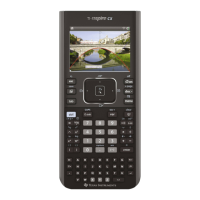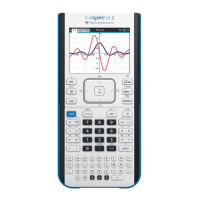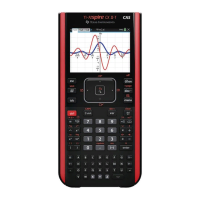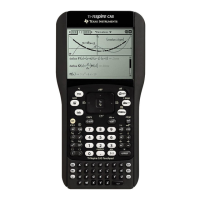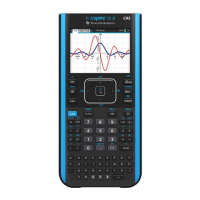TI-Nspire™ Reference Guide 13
Without a prefix, Integer1 is treated as decimal (base 10). The result
is displayed in binary, regardless of the Base mode.
Negative numbers are displayed in “two's complement” form. For
example,
N1 is displayed as
0hFFFFFFFFFFFFFFFF in Hex base mode
0b111...111 (64 1’s) in Binary base mode
N2
63
is displayed as
0h8000000000000000 in Hex base mode
0b100...000 (63 zeros) in Binary base mode
If you enter a decimal integer that is outside the range of a signed,
64-bit binary form, a symmetric modulo operation is used to bring the
value into the appropriate range. Consider the following examples of
values outside the range.
2
63
becomes N2
63
and is displayed as
0h8000000000000000 in Hex base mode
0b100...000 (63 zeros) in Binary base mode
2
64
becomes 0 and is displayed as
0h0 in Hex base mode
0b0 in Binary base mode
N2
63
N 1 becomes 2
63
N 1 and is displayed as
0h7FFFFFFFFFFFFFFF in Hex base mode
0b111...111 (64 1’s) in Binary base mode
4Base10
Catalog
>
Integer1 4Base10 ⇒ integer
Note: You can insert this operator from the computer keyboard by
typing @>Base10.
Converts Integer1 to a decimal (base 10) number. A binary or
hexadecimal entry must always have a 0b or 0h prefix, respectively.
0b binaryNumber
0h hexadecimalNumber
Zero, not the letter O, followed by b or h.
A binary number can have up to 64 digits. A hexadecimal number can
have up to 16.
Without a prefix, Integer1 is treated as decimal. The result is
displayed in decimal, regardless of the Base mode.
4
Base2
Catalog
>
Zero, not the letter O, followed by b or h.
A binary number can have up to 64 digits. A
hexadecimal number can have up to 16.
0b binaryNumber
0h hexadecimalNumber

